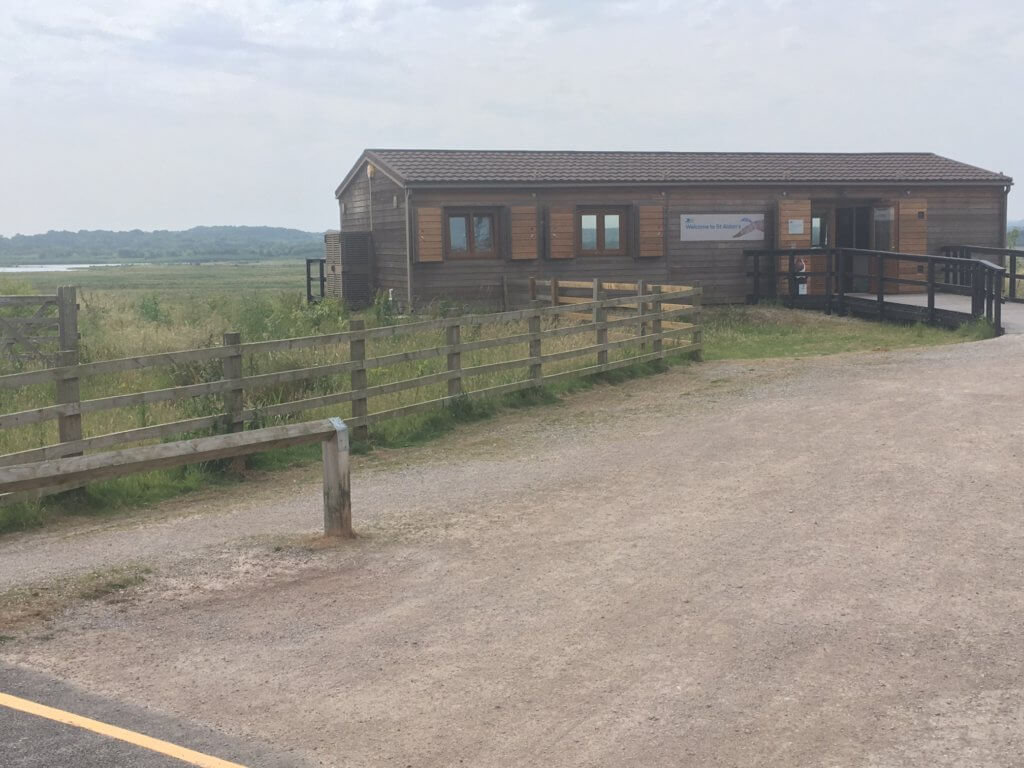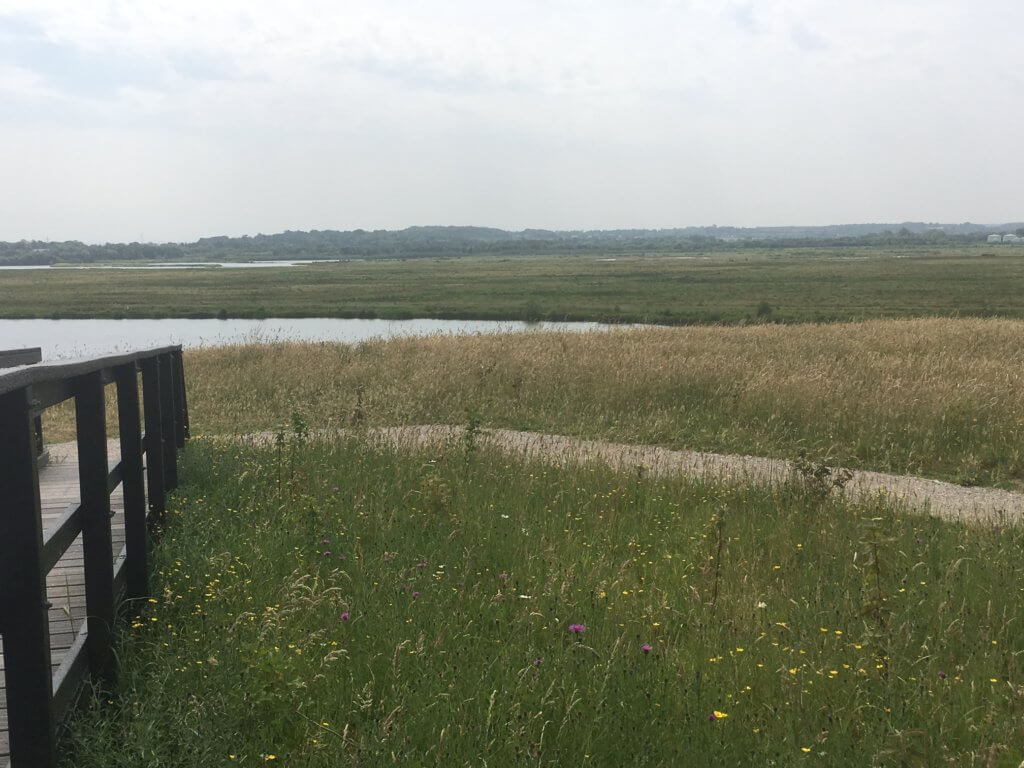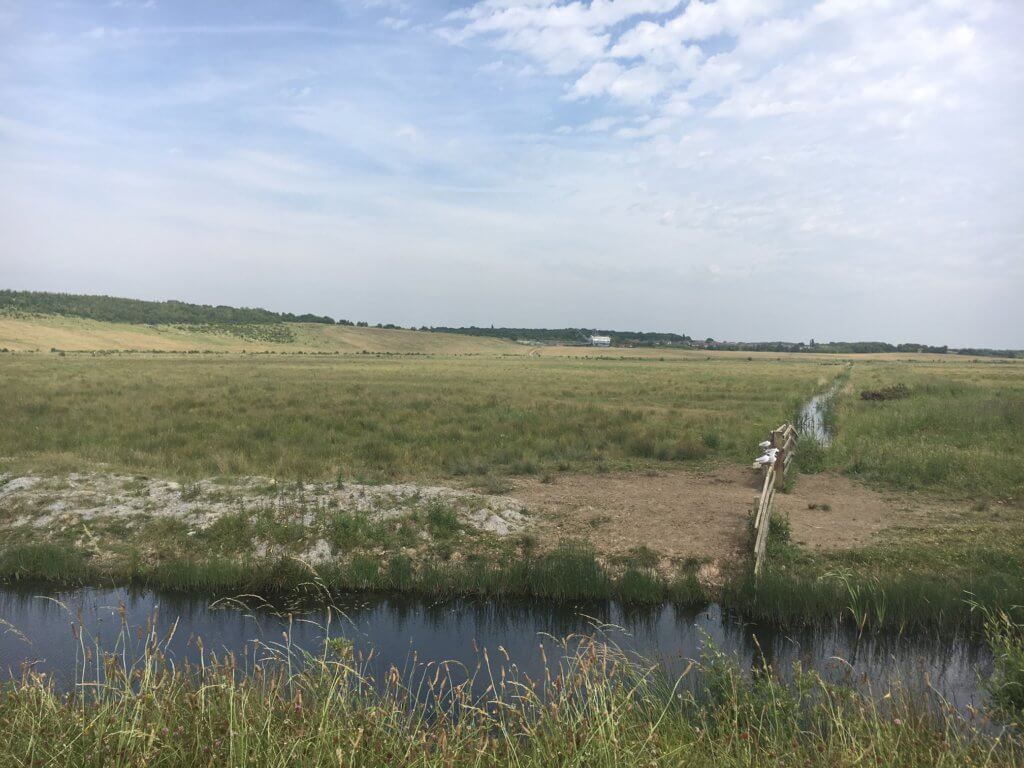
I remember visiting St Aidan’s about 10 years ago – when it was a big hole in the ground which I was told would at some time in the future be full of birds. Well, I was keen to go and see whether this promise has been fulfilled – and it has! What an amazing place. St Aidan of Lindisfarne would probably be pleased to have his name associated with this place.
The car park, a few minutes down the road from Fairburn Ings, is nothing special, and the visitor centre (where the ice creams, cold drinks and chorizo pies were very welcome) is nothing very special, but, as you can glimpse above, as you exit the visitor centre a panorama opens in front of you of quite unexpected and grand proportions. Like this…

There were lots of Meadow Browns in the foreground, gulls, ducks and terns in the middle distance and the promise of interesting wetlands on the far side of the site. I spent quite a lot of time trying to orient my memories of my previous visit all that time ago, with what I was now seeing, but I gave up and simply enjoyed the scene.
St Aidan’s opened properly (after an earlier false start – it’s complicated and to do with lawyers) this spring and so it is still something of a hidden gem on the outskirts of Leeds and Castleford. It has paths on which you can walk, run, walk your dog or cycle. It has the feel of a wildlife-rich country park rather than a nature reserve – but there is a lot of nature.
Last year a pair of Black Terns summered here and one is hanging around this year, there are 2-3 pairs of Bitterns and probably the UK’s largest colony of Black-necked Grebes. We saw several broods of Pochard – which isn’t a very common sight in my birdwatching. In autumn, as water levels drop, there are passage waders and in winter the place fills up with wintering ducks and Short-eared Owls. Not bad for an ex coal mine.
This is a site with loads of potential – wildlife potential and human and revenue potential. Nature reserves cost money to run, and we’d all have to buy an awful lot of ice-creams, cold drinks and chorizo pies to pay for the annual management of such a large site (we did our best). The annual running costs must be a moderate six-figure sum and that money has to come from somewhere; each year, and every year. I wonder whether the RSPB ought to have the occasional post-breeding season pop concert here?
The RSPB website is rather poor at promoting its nature reserves – the St Aidan’s entry would definitely not get me making the detour to go there but the reality is inspiring. If you live within an hour’s drive of the place then you should schedule a visit and I think you’ll be impressed. I plan to go back in the winter to see what’s about.
I know that the RSPB would welcome (polite) suggestions on how to develop the site as both a visitor attraction and a wildlife resource – it’s a big site and so more of both are definitely possible.
This is a big impressive nature site close to hundreds of thousands of people – it would be good if they all got to know it and love it. I’m impressed by what has already been created in quite a short period of time.

[registration_form]
With the new ‘Yorkshire’ book just out in the Best Birdwatching site series it is amazing how quickly things move on. I visited this site a few years ago when the company had gone bankrupt [hence the lawyers!] The name comes from the ‘open cast’ site not the Monk from ‘up north’ {and certainly not the Monk that has just moved to Middlesboro!!]. Many locals will still call it Swillington Ings which is part of the flood control of the River Aire just like Fairburn Ings close by. The Ings being a classic word used especially around the north for flooded winter field but now too often in summer as well! These wetlands will bring yet more needed Wildlife Tourism to Yorkshire.
I was there yesterday and it does have the feel of a country park. I like it a lot and so does my dog Sam.
You did not mention Oddball – it is very hard to miss and it does give the site a clear connection with its coal extraction past. It had a pair of little owls resting on it as well!
Fantastic site for a day out don’t visit that often but love it so do my sister and brother in law who live in Garforth and are what one might call fair weather birders. Combined with a detour to Fairburn a major birding day out can be had and yes we still call it Swillington Ings.
This is a regular place for me to visit and really good for early migrants. If the weather is right – not too warm and sunny, a bit overcast, a bit windy – it attracts stunning numbers of low-flying hirundines and swifts. Far too many sand martins to count this spring! The Swillington Ings Bird Group – hide on the opposite side of the reserve to the visitor centre – is a smashing set of people and with an impressive sightings list. St Aidan’s is yet another reserve gem in Yorkshire to add to the already impressive tally of former industrial sites: Old Moor (Dearne Valley), Fairburn Ings, Potteric Carr, Hatfield Moors, Orgreave Lagoons to name just a few.
Aidan – thanks!
I would echo the above comments but I am one of the locals and visit several times a week so may be biased. The is generally plenty to see irrespective of the time of year, not just the birds. At the moment there are plenty of wild flowers. Butterflies include White-letter Hairstreak and there is a good mix of mammals as well. There is plenty of information about St Aidan’s and the rest of the Lower Aire Valley wildlife to be found on the Swillington Ings Bird Group website @ http://www.sibg1.wordpress.com.
If anyone reading Mark’s blog lives near to St Aidan’s there is a need for more volunteers to help with managing the site.